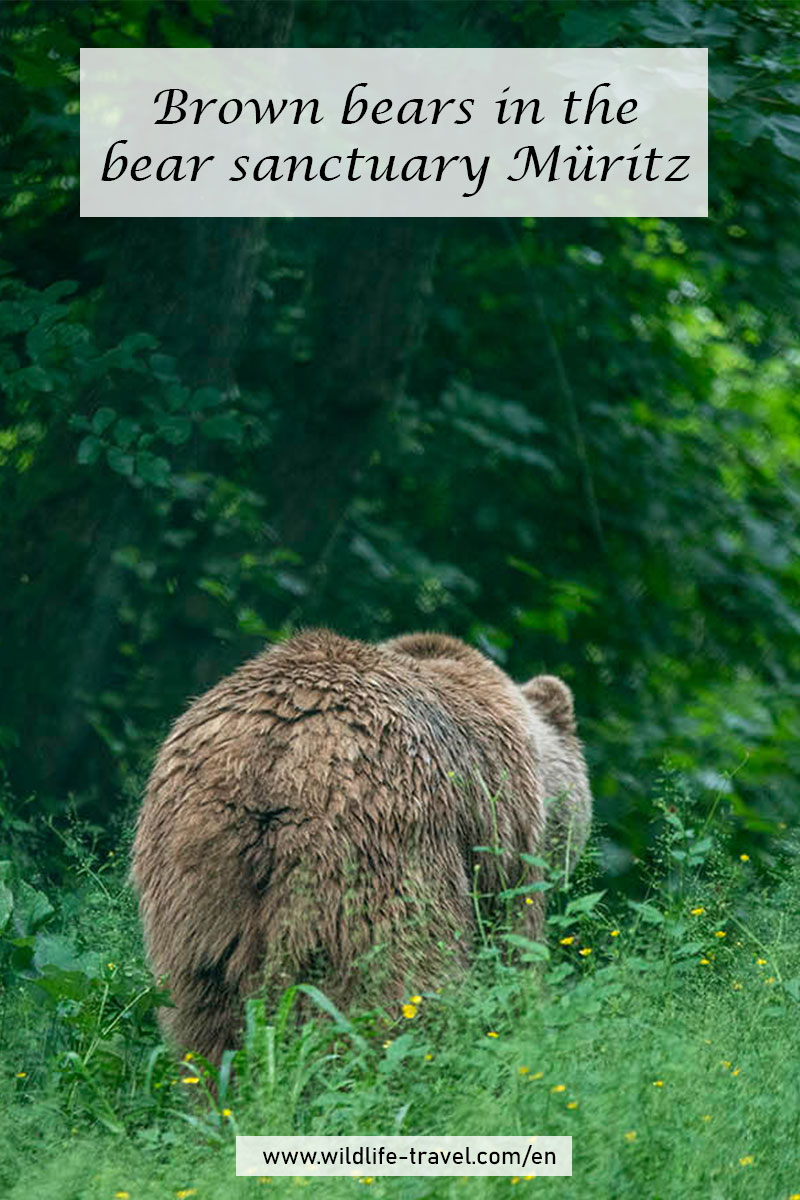The bear sanctuary Müritz is located in the Mecklenburg Lake District in North Germany and a project dedicated to the rescue of brown bears. At the moment the sanctuary provides a new home for 17 mistreated and neglected brown bears. In this blog entry I tell you more about this animal welfare project and the bears that live in the sanctuary.
Why a bear sanctuary?
The bear Balou was born in the game enclosure Hellenthal where he was kept under terrible and inappropriate living conditions with no green areas and no hiding places. Now he lives in the bear sanctuary Müritz since 2012.
Ben has a similar story like Balou. He came to the bear sanctuary in 2007 together with his mother Maya and brother Felix. Before that, Ben had to live in an enclosure made of concrete for 12 years. He shared this enclose with Felix and Maya in the “Schwarzwaldpark” Löffingen.
The bear Katja was kept in the circus Schubert in the past. After a temporary stay in an animal shelter in Nürnberg, Katja was transferred to the animal park Kalletal where she had to live in a small enclosure for several years. Now she lives in the bear sanctuary Müritz, too.
Ida was confined to a small enclosure in the animal park Kalletal, too.
Sylvia and Pavle lived in a small cage in a circus.
And Rocco was kept as a pet in a small cage in Albania.
And so on.
I could continue with more sad stories of bears that lived under terrible conditions in the past.
Now, all of these bears – 17 bears in total (June 2019) – can live under more species appropriate living conditions in the bear sanctuary Müritz.
All of these 17 bears in the bear sanctuary share a similar story of mistreatment.
Some came from abroad.
While others had to live in a circus.
And other bears had to be transferred from one inappropriate facility to the next.
Luckily, all of these bears in the bear sanctuary now can live a more natural bear life in a forest where they can live out their natural instincts again.
Now they can wander around.
Take a bath in one of the many ponds.
Burrow holes.
They even can go dormant in winter.
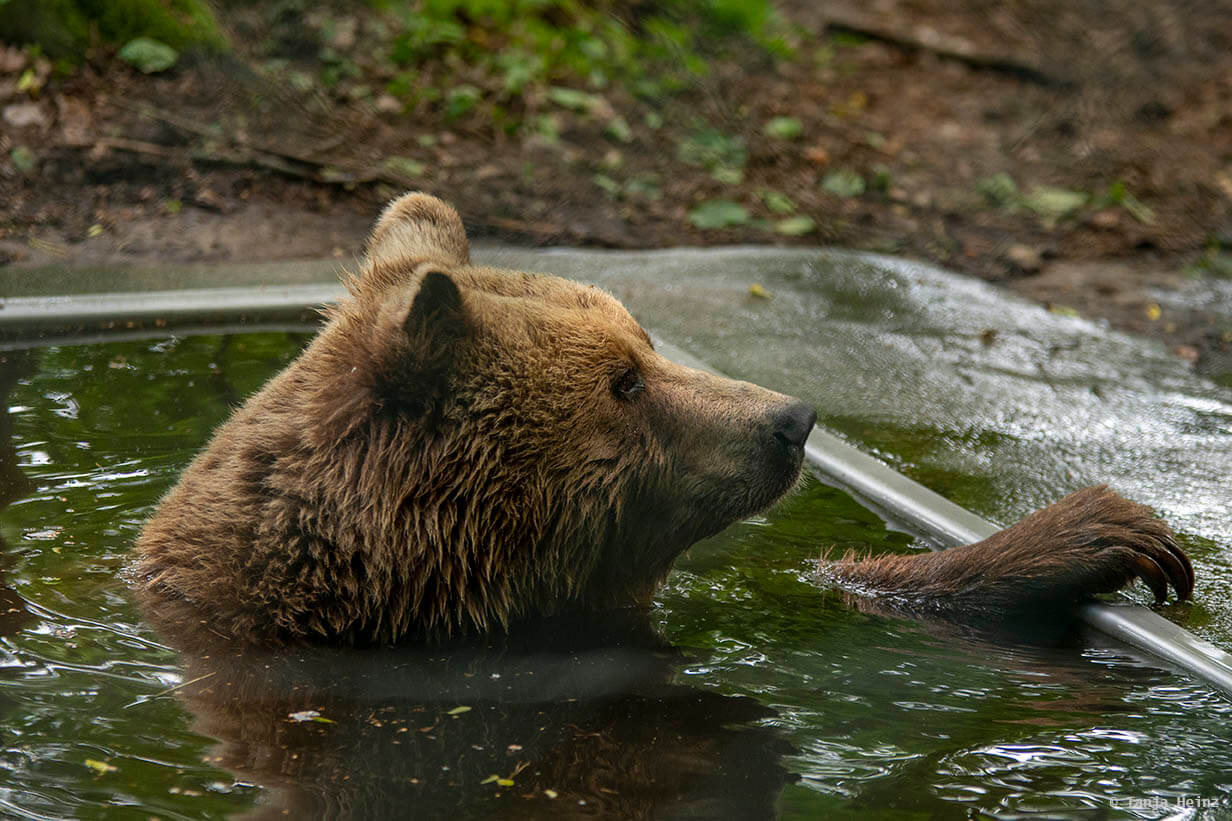
Maybe now you ask yourself why do we need such a bear sanctuary and why not just let them free into the forests anywhere in Europe?
Well, as all bears were kept under non-natural living conditions it is not possible to return them into the wild again. They are too dependent. They are used to human presence. They haven’t learned how to survive in their natural environment.
That is why the bear sanctuary Müritz was established to provide a new and especially more natural home for bears which cannot be introduced into the wild again.
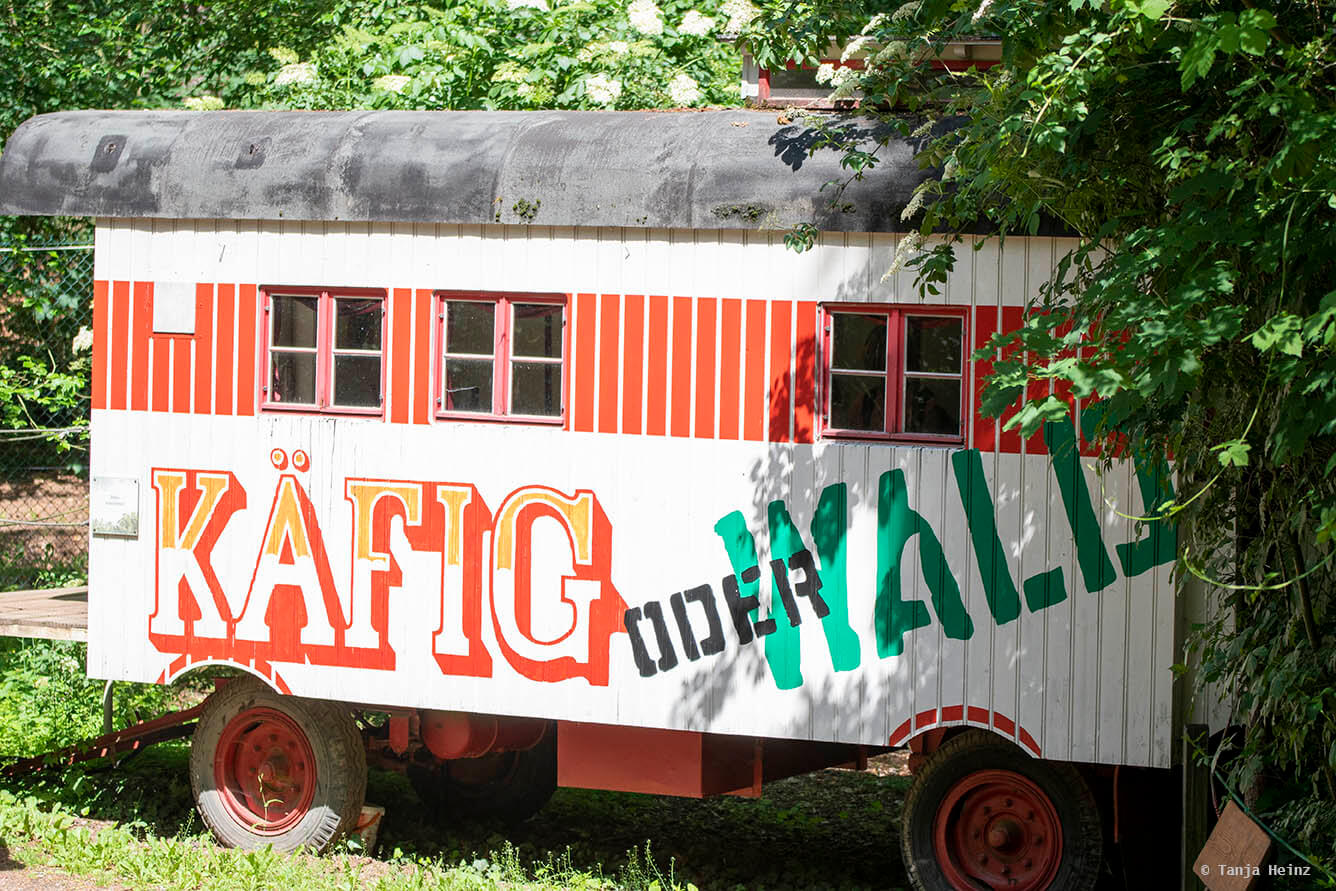
There are two more important points I have to mention here.
Firstly, the bear sanctuary was not established for people who wish to see bears. The bear sanctuary is not an exhibition of bears. Animal welfare is the top priority of the bear sanctuary and not the satisfaction of visitors. Bear that in mind and don’t expect to see too much of the bears. There are good days and the bears show up, but there are also days when the bears prefer to hide anywhere in the forest and you will not be able to see much of them.

The second important point is the fact that the bear sanctuary does not have any breeding program. The bear sanctuary was created primarily with the intention to establish a new and more natural home for mistreated bears.
I think these two points are very important to mention as most zoos, for example, were created based on other intentions.
Information: It is possible to visit the bear sanctuary Müritz at any time of the year. Even if you do not see a bear on your visit, there is much to learn and explore in the forest of the bear sanctuary. Even for children there is a playground area.
The bear sanctuary Müritz
Although the bear sanctuary Müritz was created primarily with the intention to rescue bears living under inappropriate living conditions, the sanctuary is open to the general public. I have to say that I was very impressed by the work of the bear sanctuary. When I visit a place where animals are not free, I always go there with mixed feelings. But in the bear sanctuary I was very happy to see a good place for brown bears.
The first thing I very liked in the bear sanctuary was the fast area for the bears and the possibility for them to hide in the forest. The other thing was their education efforts. I will go more into that in the next paragraphs.
The bear sanctuary comprises an area of about 16 hectares. A hiking trail winds through beautiful woodland where you can learn not only more about bears in general, but also enjoy the nature of the Mecklenburg Lake District.
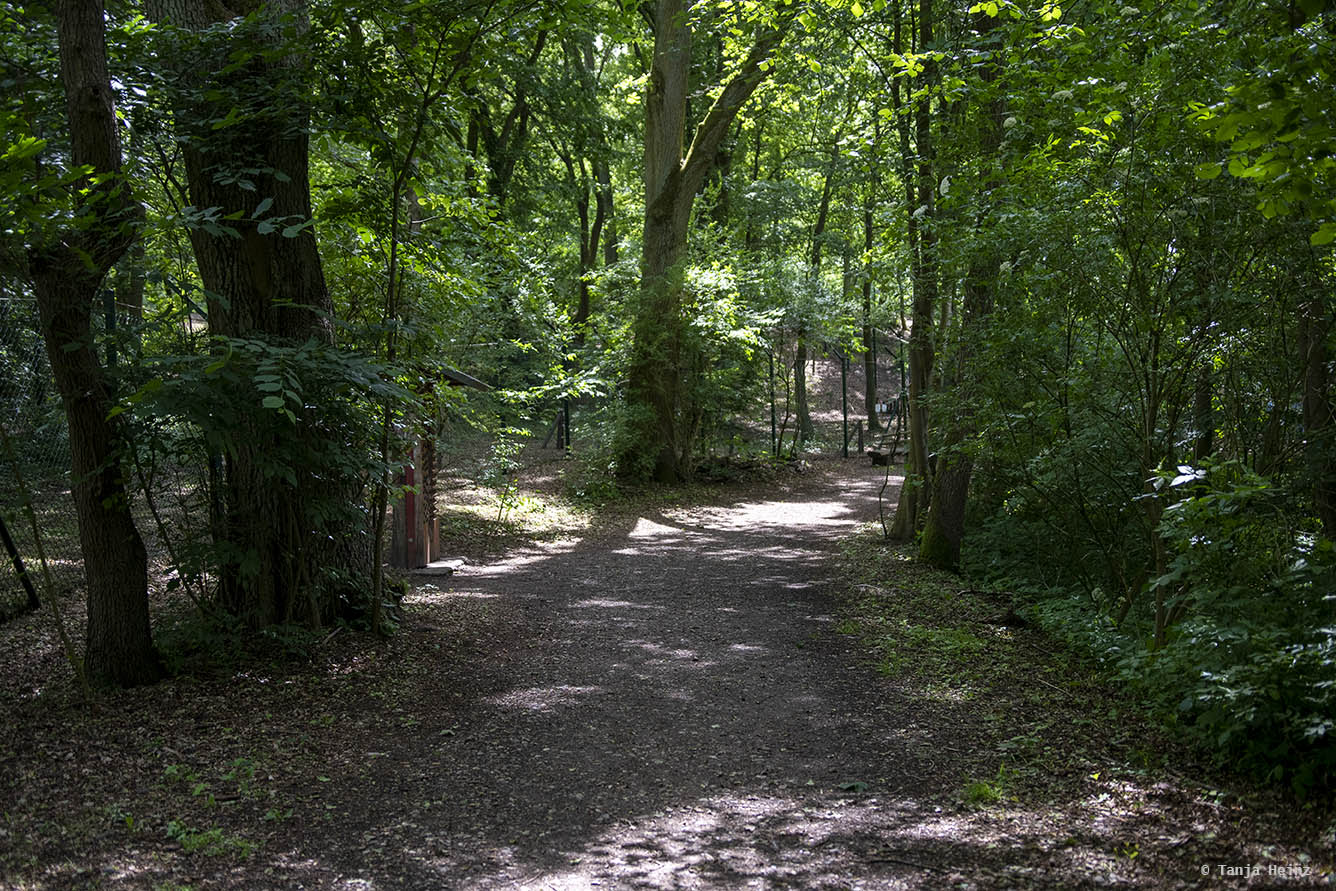
The first bear I saw in the bear sanctuary was Otto. He was previously kept as a pet anywhere in East Germany. He was born in 1992 and lives in the bear sanctuary since 2006. He was named after a politician who was very supportive when the bear sanctuary was established.
Otto is a very playful bear and very popular among visitors. One of his favourite activities is to burrow small and comfortable wells where he can sit for a while.
On the day of my visit Otto was confined in a small area. However, only temporarily. As animal attendants in the sanctuary sometimes have to enter Otto’s and all other bear’s main enclosures (the big and forested ones), the bears have to be kept temporarily in smaller enclosures. Animal attendants have to enter the main enclosures sometimes to hide food, fix a fence or do other work. As the animal attendants need to work safely, the bears have to be transferred temporarily into smaller enclosures. Therefore, if you find a bear in a small enclosure in the bear sanctuary, bear in mind that the bears will stay there only temporarily. Nevertheless, signs in the bear sanctuary also will make you aware of this.
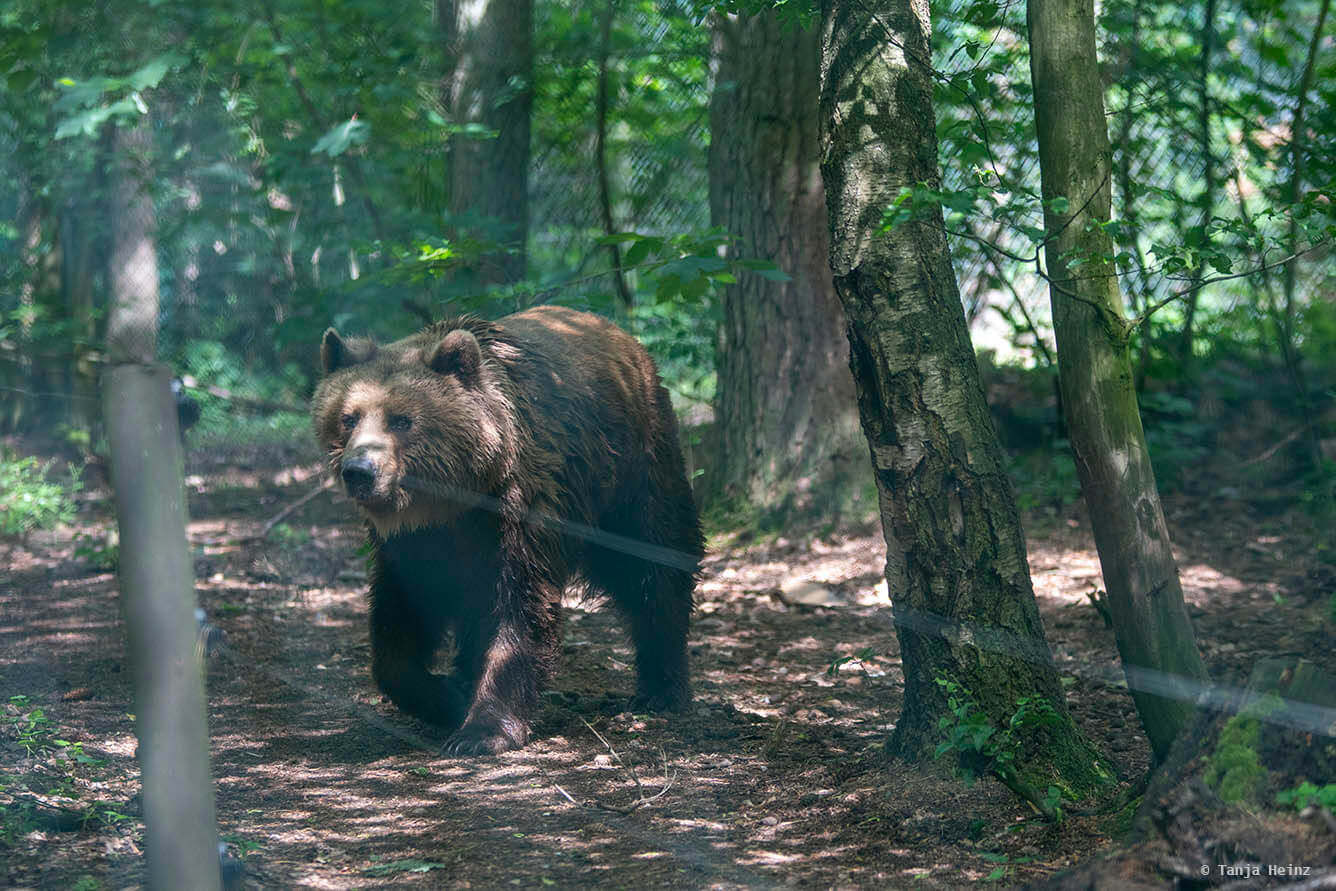
When you pass the entry area and the small enclosure where Otto stayed temporarily, you will see already the main enclosures of the bears. On the day of my visit I could not spot any of the bears there. Therefore, instead of observing bears I took a seat in one of the stubs of a tree positioned by the people of the sanctuary and listened to the stories of the bears which came out of some loudspeakers. I was not alone. Some more visitors quietly listened to the stories.
After listening to the stories of the bears I continued walking through the woodland. I passed a playground and a bear cemetery. On that cemetery are buried all the bears that died in the bear sanctuary.
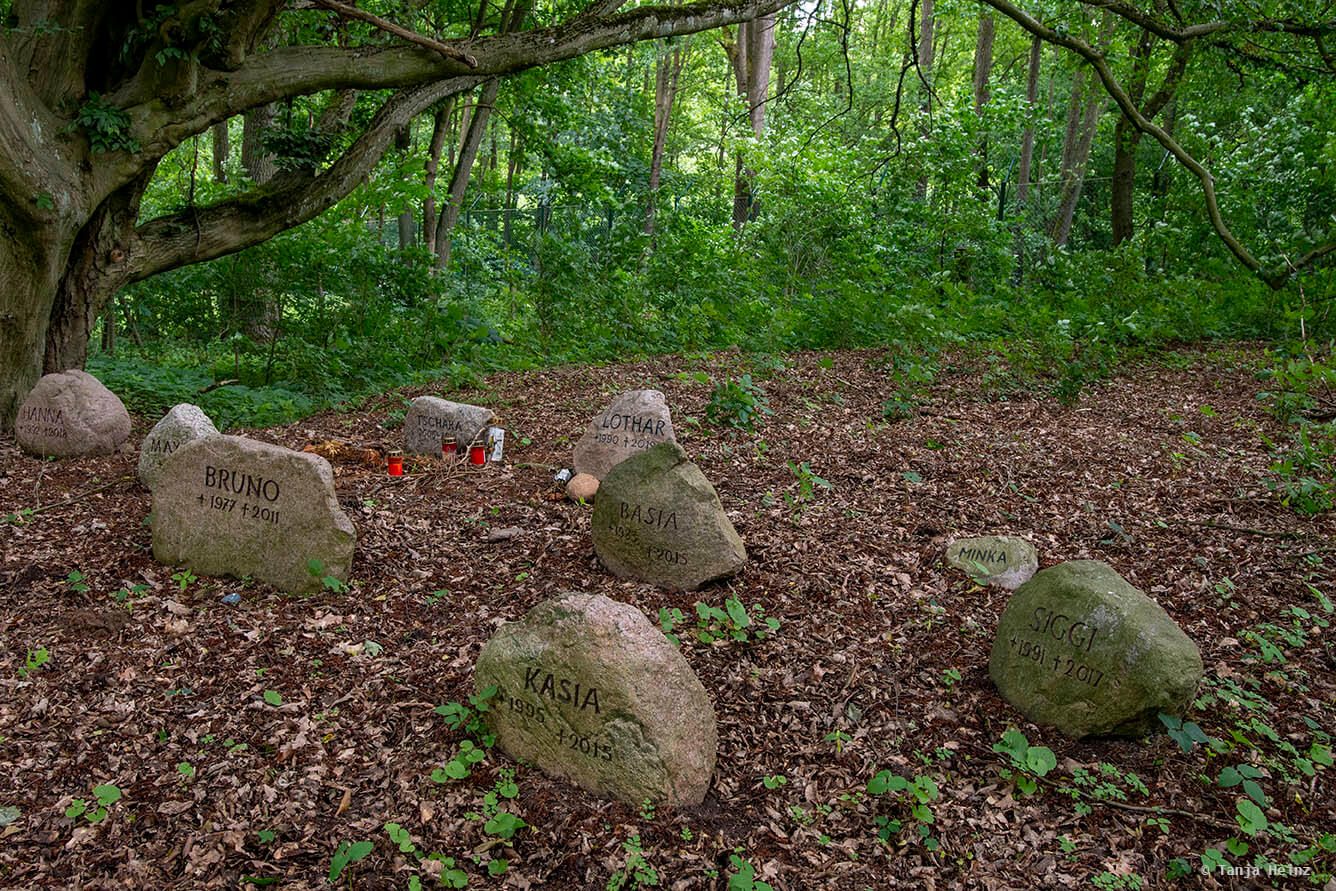
After the bear cemetery I arrived in another sad place of the bear sanctuary. In this place the bear sanctuary informs its visitors about bear mistreatments.
According to the organization FOUR PAWS, still hundreds of bears are kept under inappropriate keeping conditions. Often illegally.
Some bears have to live in the back yard in chains or in cages of a restaurant in Eastern Europe in order to attract customers. Some have to show some tricks or dance for tourists. While others have to pose for a selfie with people. In a video I saw how bears are even used for the training of hunting dogs.
Unbelievable.
The aim of FOUR PAWS is to ban these practices and establish more bear sanctuaries like the one in Müritz. The NGO could already ban using dancing bears in Serbia and Bulgaria. However, this does not mean that bears do not have to suffer in these countries anymore. Even in Germany there are still places where bears are kept in small enclosures made of concrete.
When I passed another small enclosure (this was again an enclosure where two bears were kept temporarily) I could observe that this bear had to suffer in the past. This bear was walking in a circle on only three of its four paws. Again and again.
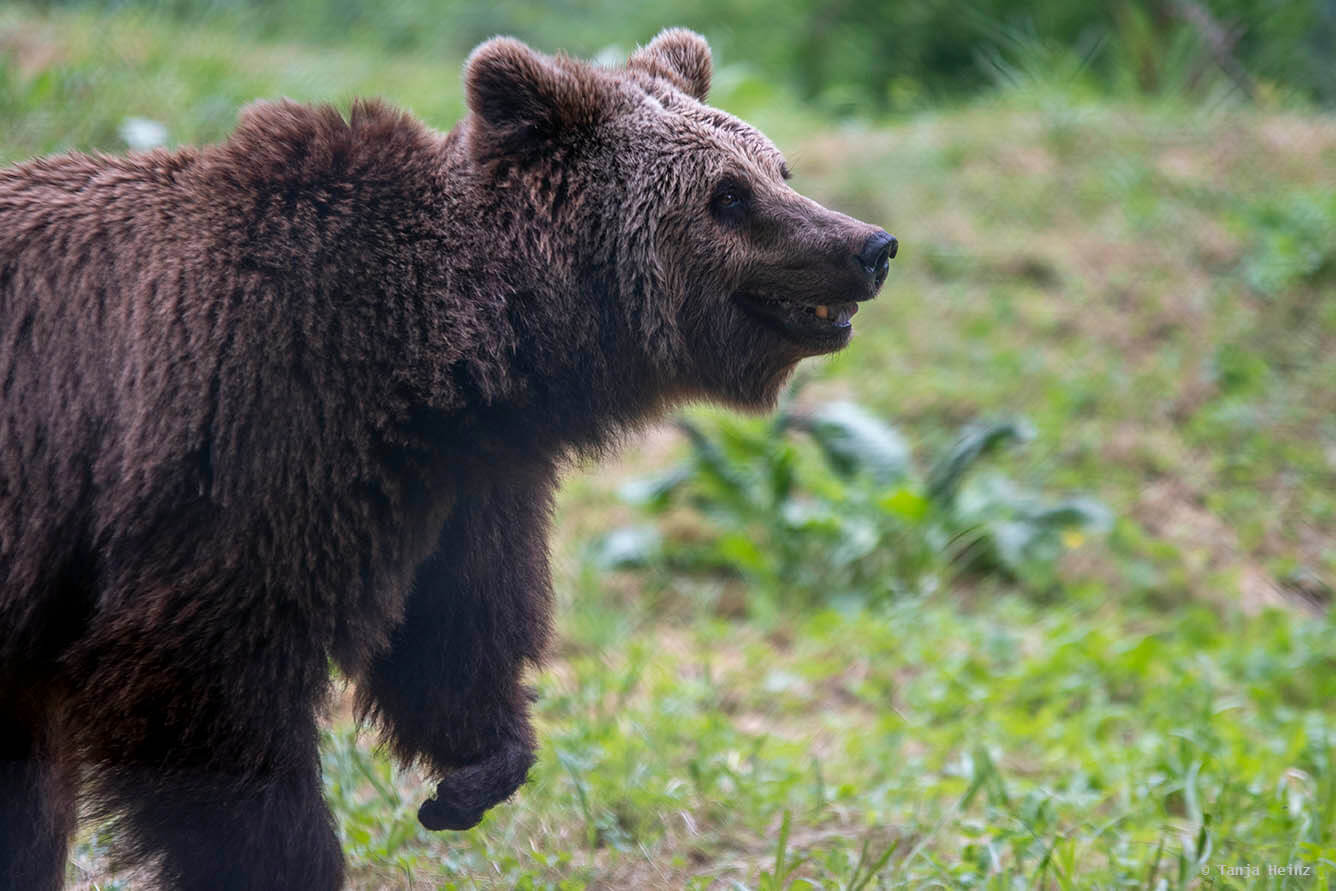
I could not find out the name of the two bears, but anyway I could clearly see that this bear had a history of mistreatment.
Maybe now you are also wandering why did this bear walk in circles?
This behavior is also known as a stereotype. Stereotypes are movements which are repeated again and again and do not have any aim or function for the animal. Stereotypes develop when an animal feels stressed, bored or when it is not allowed to live its natural behavior. Bears might show stereotypes in different ways. A bear might jump up and down, walk in a circle again and again or gnaw on the bars of a cage. When a bear lives under inappropriate conditions for many years a stereotype or behavior habit, respectively, might remain even when living conditions improve. Important to mention here is that stereotypes are not always negative. Sometimes they can help an animal to cope with stress.
This bear was walking around a bush again and again in the sanctuary, too.
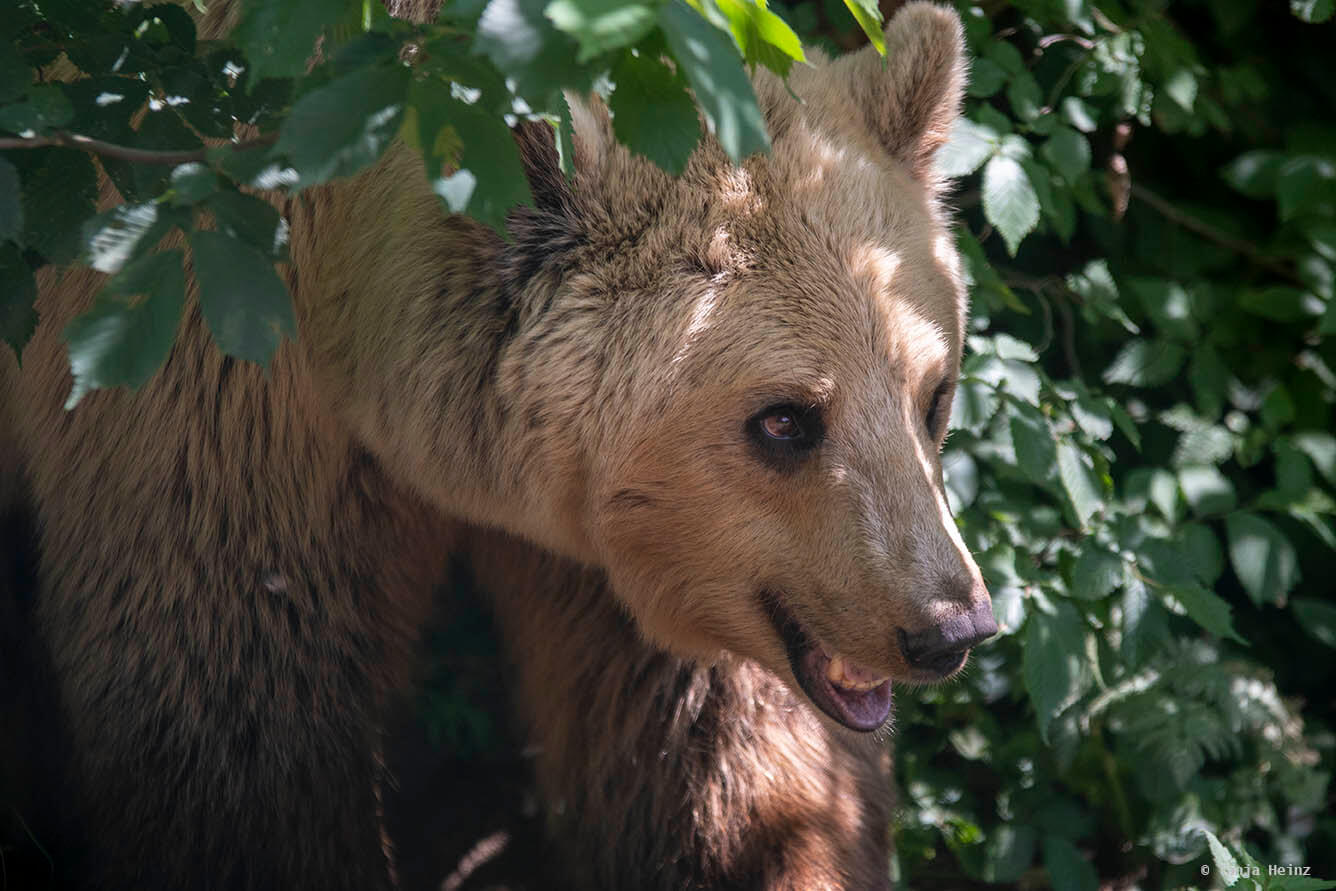
In the bear sanctuary the staff tries to keep the environment of the bears as diverse as possible. They call this “enrichment”. This word means that the staff of the sanctuary hides food for the bears to keep them busy as this way the bears have to take some time to search for it. They also construct puzzling toys in order to provoke the curiosity of an animal.
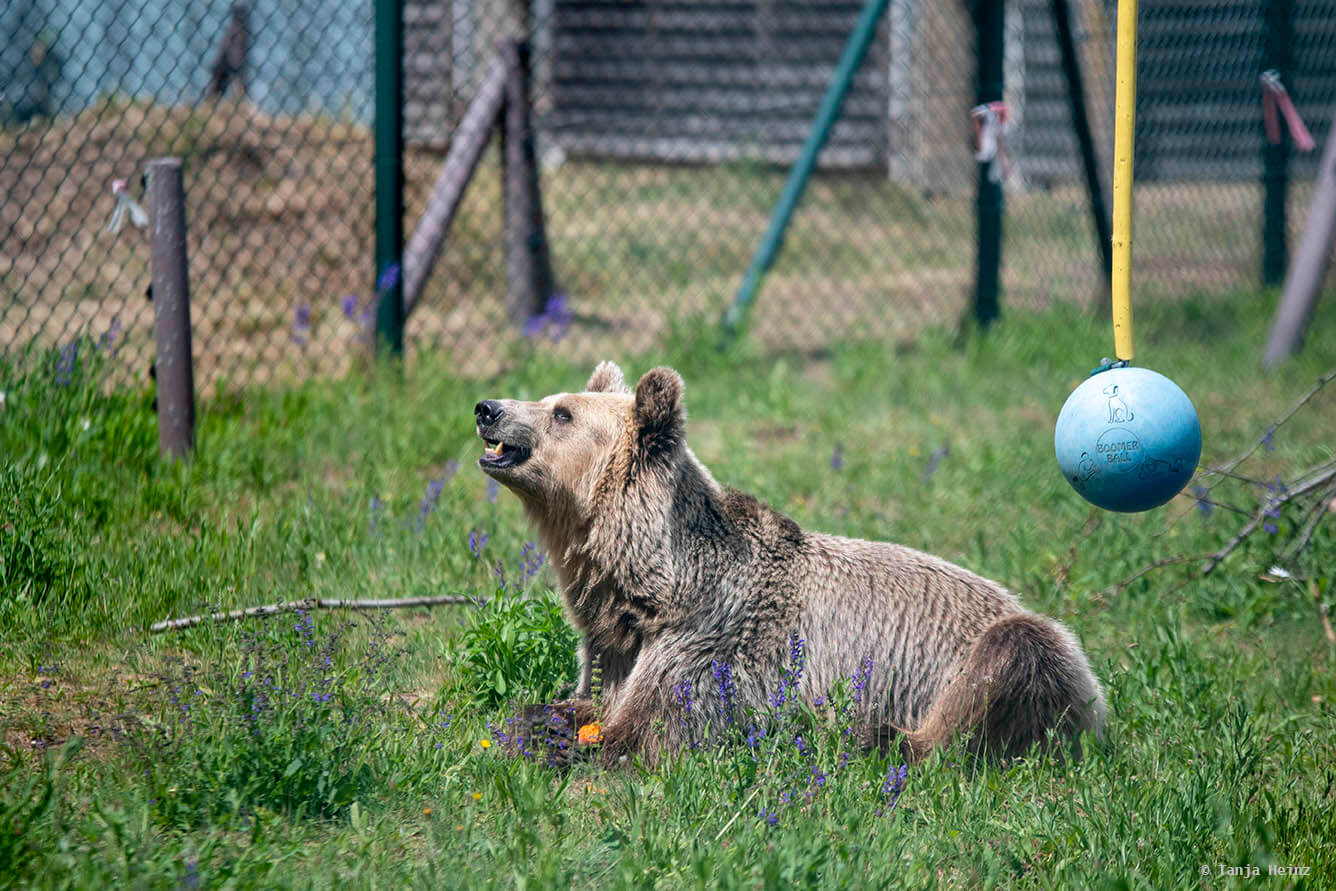
Visitors as well are encouraged to learn more about the bears of the sanctuary and their natural environment. If you visit the bear sanctuary with your family or friends you can stop at one of the many games in the sanctuary and play some memory at one of the boards.

My favourite game in the sanctuary was a labyrinth with many questions about bears. If you know the answers you will find the right path out of the labyrinth. If you go attentively through the bear sanctuary everyone is able to answer all questions.
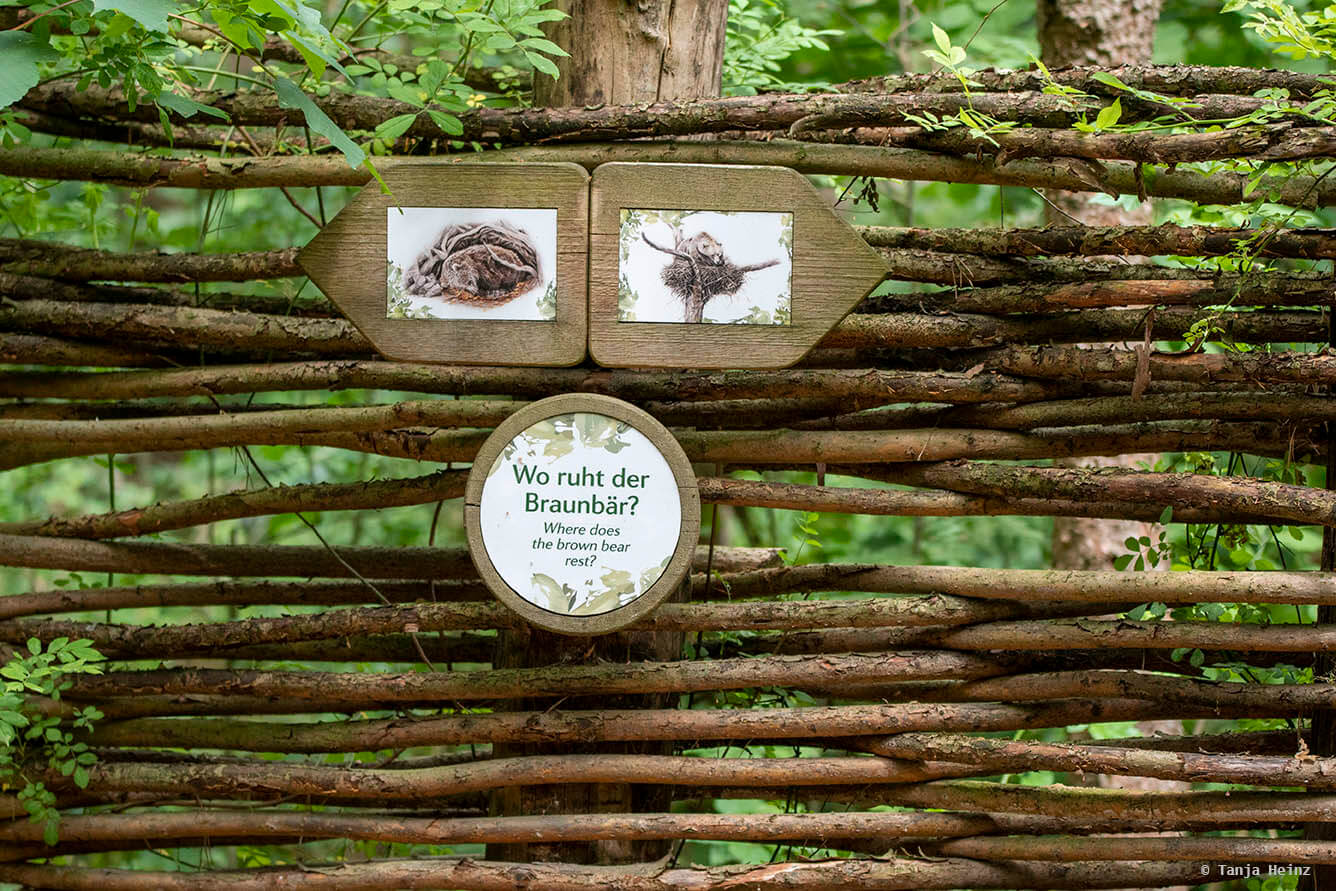
Close to the labyrinth was an observation platform where I could get some great bear observations from above. One bear was approaching to another bear close to the water. I was not the only one who spotted the two bears. Children could play around the observation platform. A slide connected the observation platform with the ground. Many children used this. Although it was loud the bears did not care. They sat quietly close to the water taking a bath in the sun.
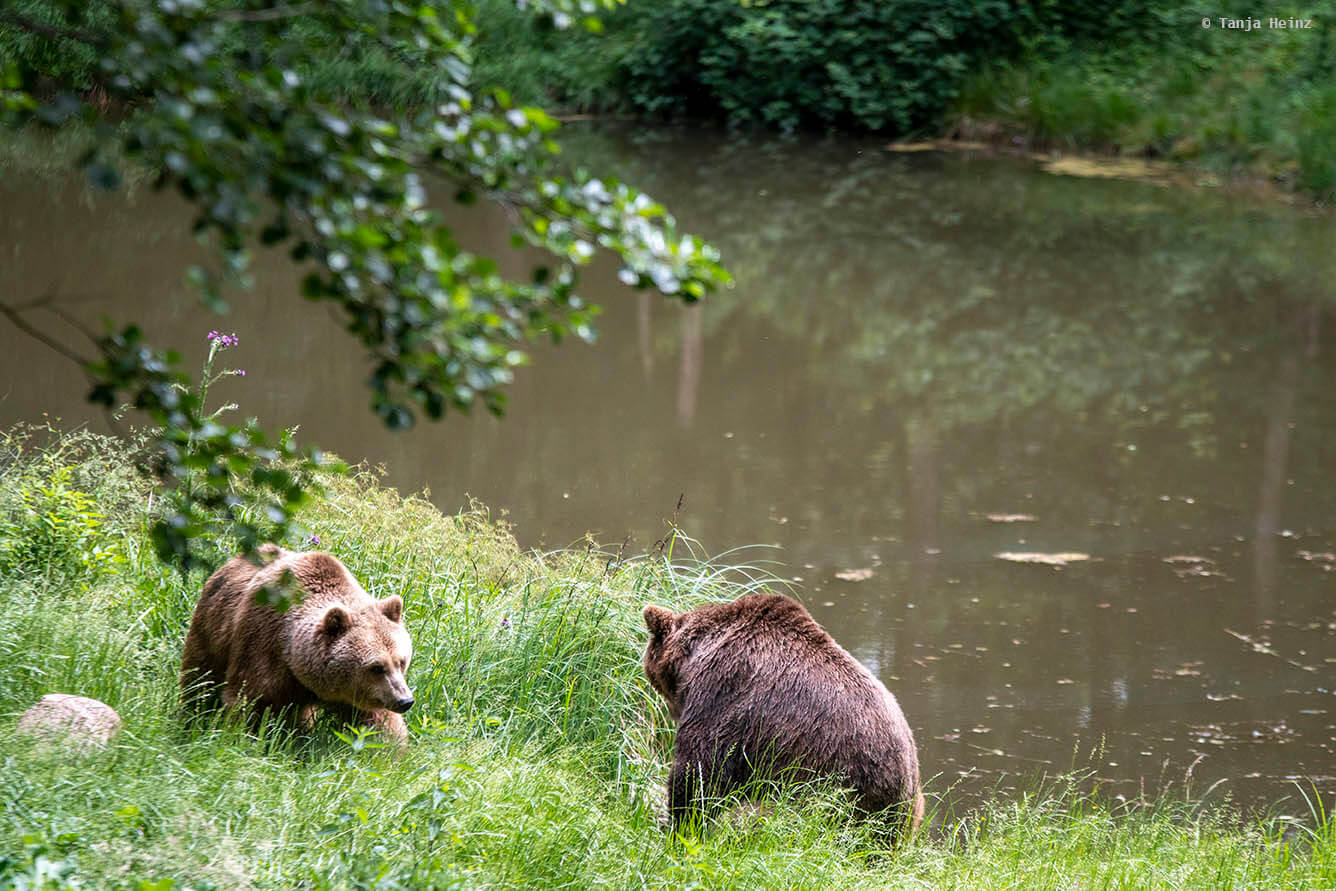
By the way, the observation platform was another great education area. At this place you could learn more about all the animals that live in the forest like, for example, the edible dormouse. I think the bear sanctuary has done a great work with respect to education. It was informative, but not boring and you can test your knowledge in the plays around the sanctuary.
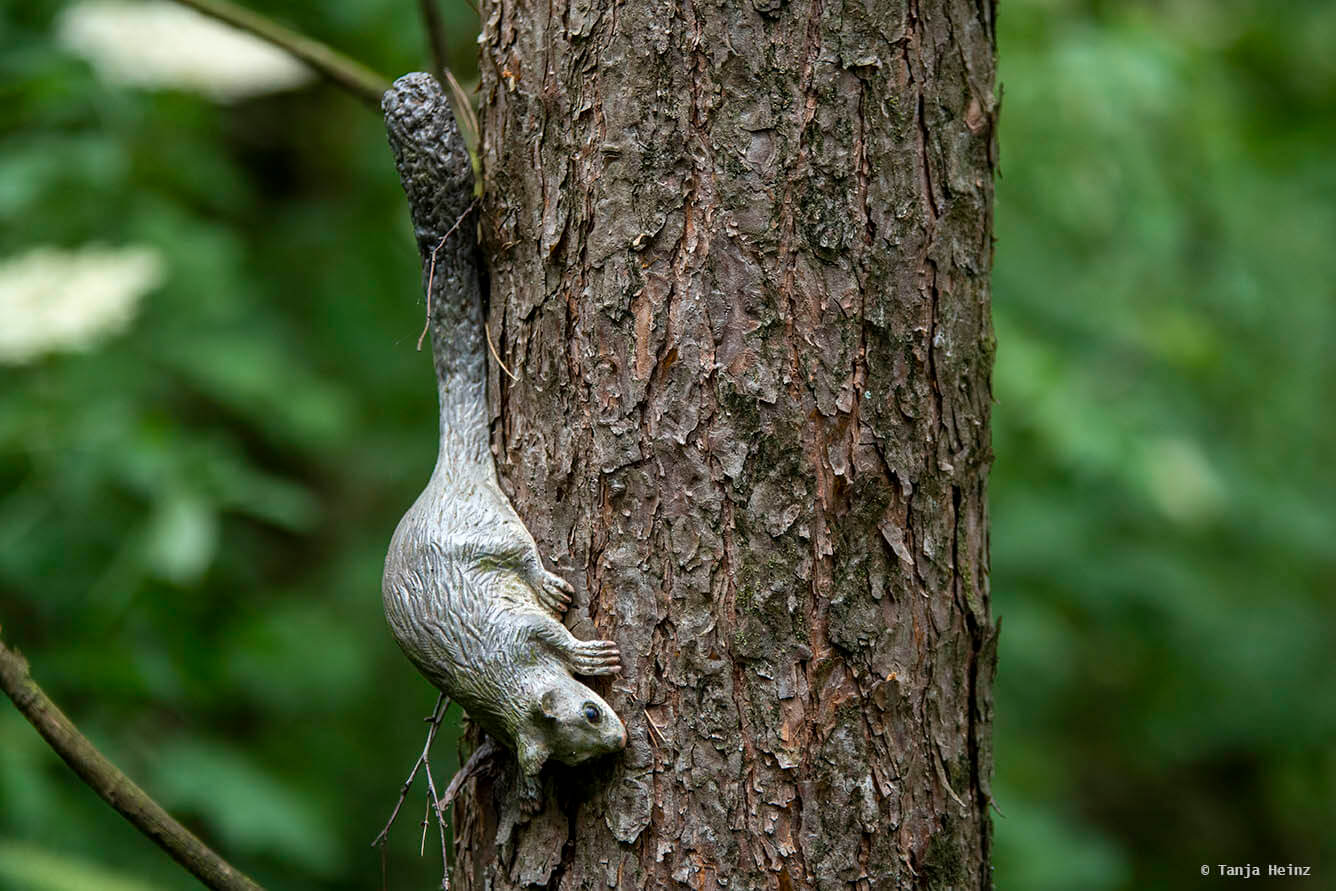
Information: By the way, the Stuersche Bach, which runs through the bear sanctuary, is a great place to spot other wildlife like, for example, Eurasian otters (Lutra lutra), European badgers (Meles meles) or red foxes (Vulpes vulpes), but also bats like serotine bats (Eptesicus serotinus), common pipistrelle (Pipistrellus pipistrellus) or Daubenton’s bat (Myotis daubentonii). Bird watchers can observe white-throated dippers (Cinclus cinclus), common kingfishers (Alcedo atthis) and sometimes even grey wagtails (Motacilla cinerea).
Brown bears (Ursus arctos)
The bear sanctuary Müritz provides a home to brown bears. As I could learn so much about brown bears in the sanctuary, I would like to introduce here the brown bear as a species.
Where do brown bears live?
What do they eat?
Or how do they live? Alone or in groups?
I will go into these questions in this paragraph.
First of all, there are many different subspecies of brown bears. In the bear sanctuary Müritz lives the Eurasian brown bear (Ursus arctos arctos). Among scientists there is apparently still a big discussion about how many brown bears there are. Nevertheless, another subspecies is the grizzly bear in North America (Ursus arctos horribilis) or the largest brown bear – the Kodiak bear (Ursus arctos middendorffi) – on the islands of the Kodiak Archipelago in Southern Alaska.
Just to name a few.
There are several subspecies of brown bears, but in this paragraph I will focus only on the Eurasian brown bear. If I write just brown bear, I actually mean Eurasian brown bear.
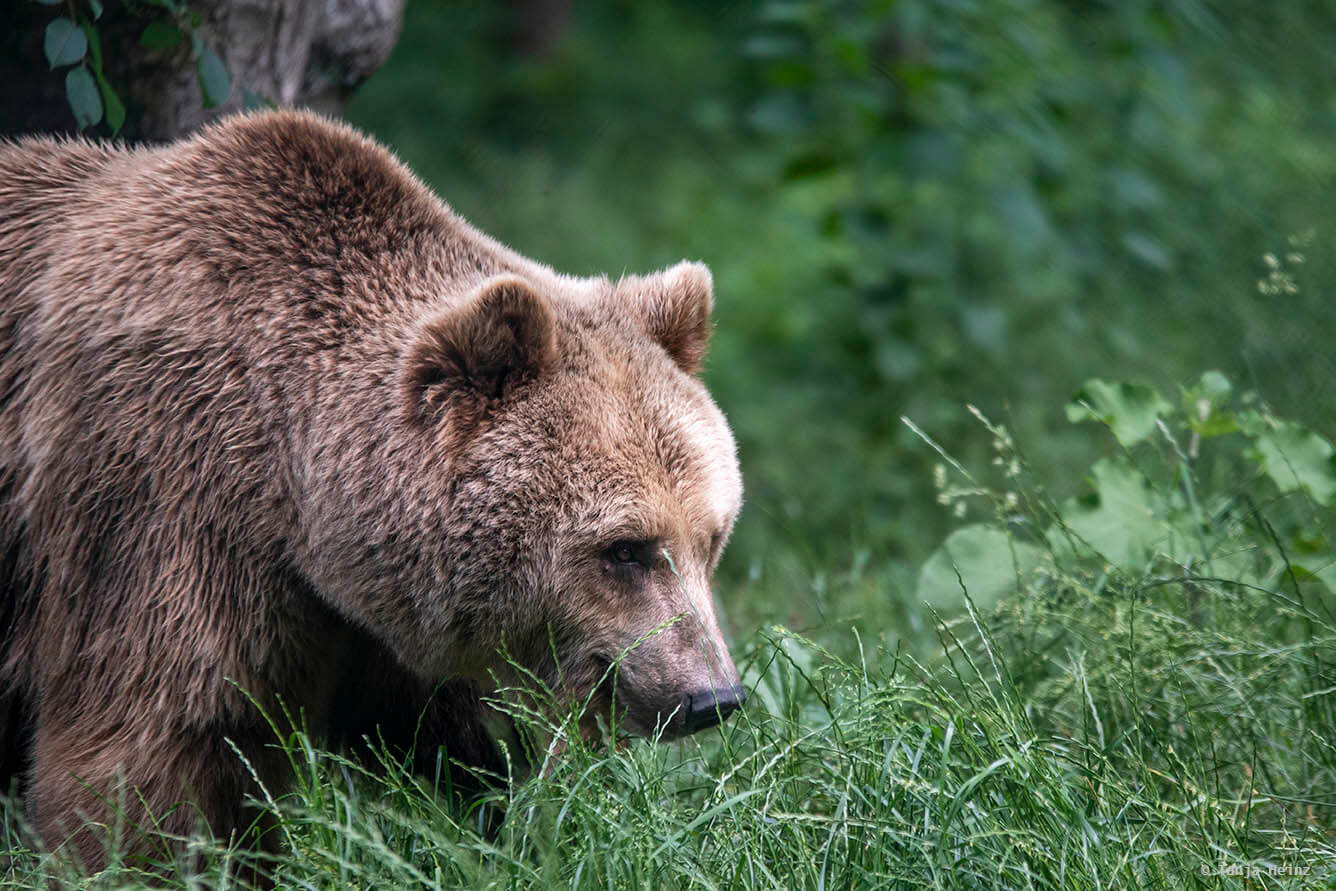
Female brown bears reach a weight of about 90 to 160 kg, and thus, are smaller than males which can weigh between 200 and 320 kg. In the course of the year the weight of a brown bear varies greatly, but reaches its yearly maximum in autumn.
Interesting fact: Brown bears are plantigrades, that means, they use their entire sole of the foot to walk. Big cats, in contrast, walk only on their toes.
Brown bears are loners. Only in the mating season females and males accept the company of another bear. Mating season starts in May and June. A male and female stay together for some time, but after mating they separate again and look for other females or males, respectively. Brown bears mate with several other bears in order to increase mating success.
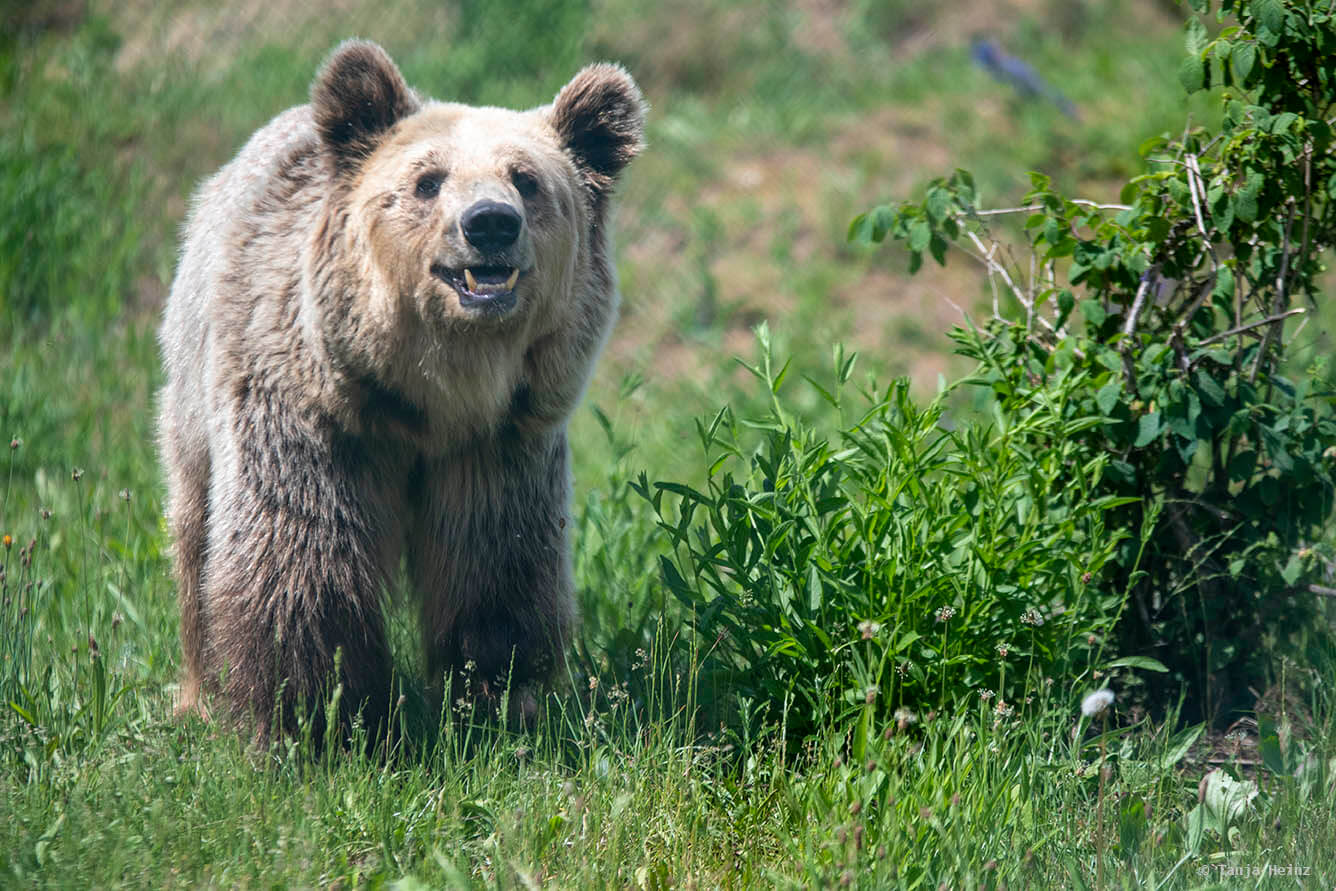
Although the mating season starts in spring, a female will become pregnant only in autumn when she has gained sufficient weight. In poor years with little food resources a female might not become pregnant as her offspring would not survive.
Females give birth in February in their winter dens. They raise the cubs alone without a male. Females nurse their offspring for about five months and leave them after three years.
Interesting fact: Did you know that male brown bears might kill the offspring of a female? As only females without offspring are receptive, a male might kill all cubs in order to mate with the female as soon as possible.
Sometimes social bonds between offspring are so strong that they remain together for some more years in order to hunt together and play with each other. However, after the beginning of sexual maturity every bear lives a solitary life.
As adults every brown bear lives in a territory called home range. Brown bears do not defend their territories against other bears. However, the home range of a male usually overlaps with the home range of several females. Brown bears search for food within their home ranges. If there is little food in one season, brown bears increase their home range in order to find food. They use about 16 hours every day for this activity. On average, brown bears travel about 40 kilometers every day on their search for food.
Interesting fact: A female might insistently chase away her offspring. This is important as this way brown bears avoid inbreeding.
Another interesting fact about brown bears is their ability to save energy during winter by reducing circulation, respiration and heartbeat. This phenomenon is known as winter dormancy. However, scientists still discuss about the right name for this state. Is it winter dormancy or hibernation?
I cannot give you here a clear answer, but fact is, the winter dormancy state in brown bears is not that strong like the hibernation state in edible dormice, marmots or hedgehogs. This is probably because brown bears need to wake up fast if they have to defend their winter dens. If a brown bear would be in hibernation like a marmot, the animal would have difficulties to start up its body functions.
Before brown bears go into winter dormancy, they have to feed on energy-rich food in autumn, as they do not eat at all in winter and they lose one third of their weight during the winter months.
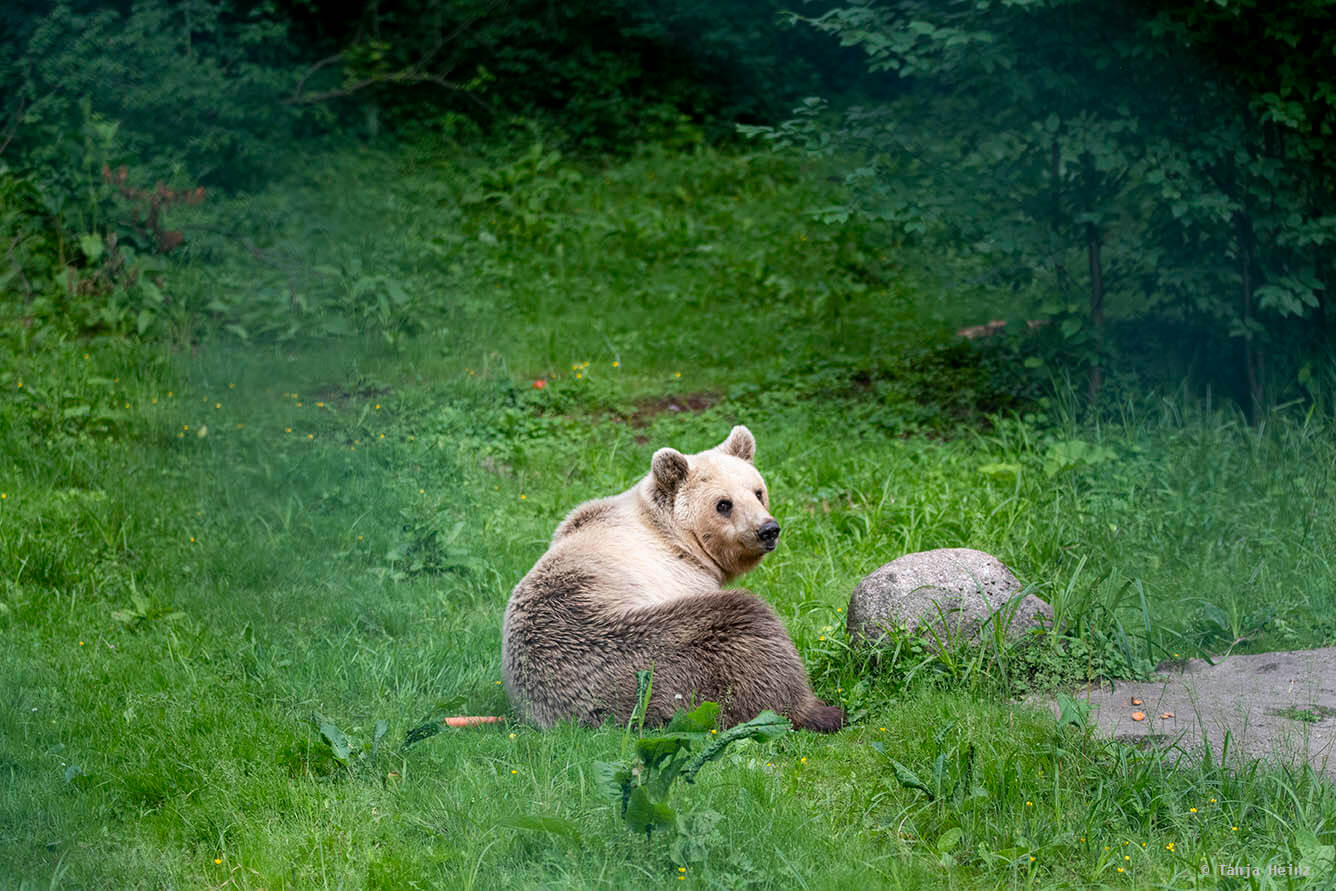
However, there is one more thing to mention with respect to winter dormancy. Every brown bear is individual. Thus, there is not a specific beginning or ending of a winter dormancy. Some brown bears even skip winter dormancy.
Important: In the bear sanctuary the bears have the choice to go into winter dormancy. Every good facility for brown bears is a facility that gives the bears the chance to go into winter dormancy. In an enclosure made of concrete this is not possible, as brown bears burrow a winter den or use other holes in the ground to go into winter dormancy.
Although there is still much to learn about brown bears, we know already quite a lot about them.
We know that brown bears are preferably active at dusk and night.
We also know that brown bears in the wild can reach an age between 20 and 30 years.
Furthermore, we know that brown bears are not very specialized, but very adaptable and omnivores.
And did you know that brown bears once lived in Germany?
However, since 1835 brown bears are considered as extinct in Germany. Only about 100 brown bears live in Germany in zoos, animals parks or other facilities.
In the bear sanctuary I also learned that brown bears are very good swimmers. Although I haven’t seen any bear swimming in the water, I learned that they are able to do so.
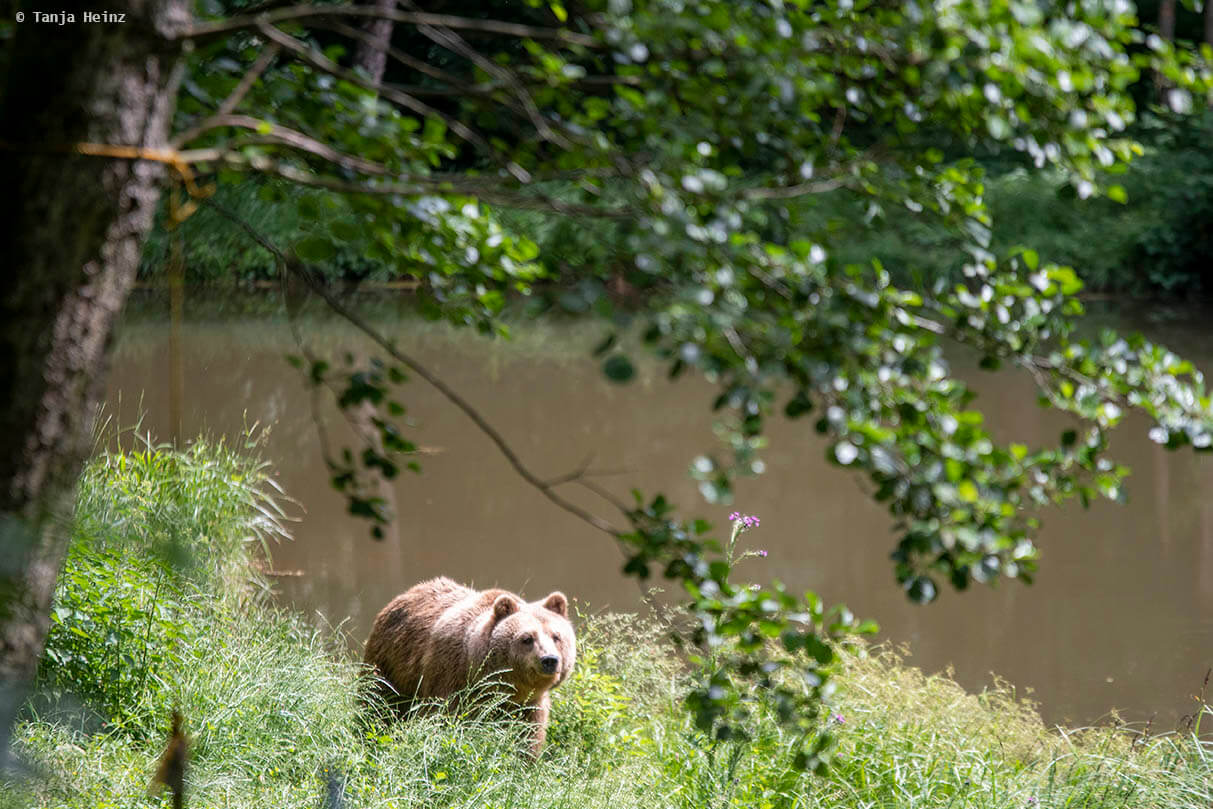
Apparently young brown bears are also very good climbers. Especially in dangerous situations young brown bears might climb up a tree in order to find protection. Adult bears, in contrast, are too heavy, and thus, usually do not climb like young individuals.
Although brown bears look very docile, they are able to reach a speed of up to 50 km/h. However, usually only for a short distance as due to their thick fur they might overheat.
Do you remember Bruno? Bruno was a brown bear that migrated in May 2016 into Bavaria. In Bavaria Bruno was considered as a “problem bear”, as he started to tear sheeps and destroyed beehives. Therefore, Bavaria authorized hunters to shoot the bear. After several protests they tried to catch him in order to transfer him to another places. As this did not work, Bruno was finally killed about one month later after its first appearance in Germany.
Practical information
Arrival by bike
As most people in the sanctuary were families with small children, most people arrived by car. However, the region around the bear sanctuary is wonderful, and thus, perfect for a bike tour. I stayed in Malchow, and thus, cycled from Malchow to the bear sanctuary in Müritz.
However, bear in mind that most of the time there are no separate cycle paths and you have to share the street with cars. There is a cycle path close to the bear sanctuary, however, from Malchow to the bear sanctuary Müritz I could not find any path only for bicycles.
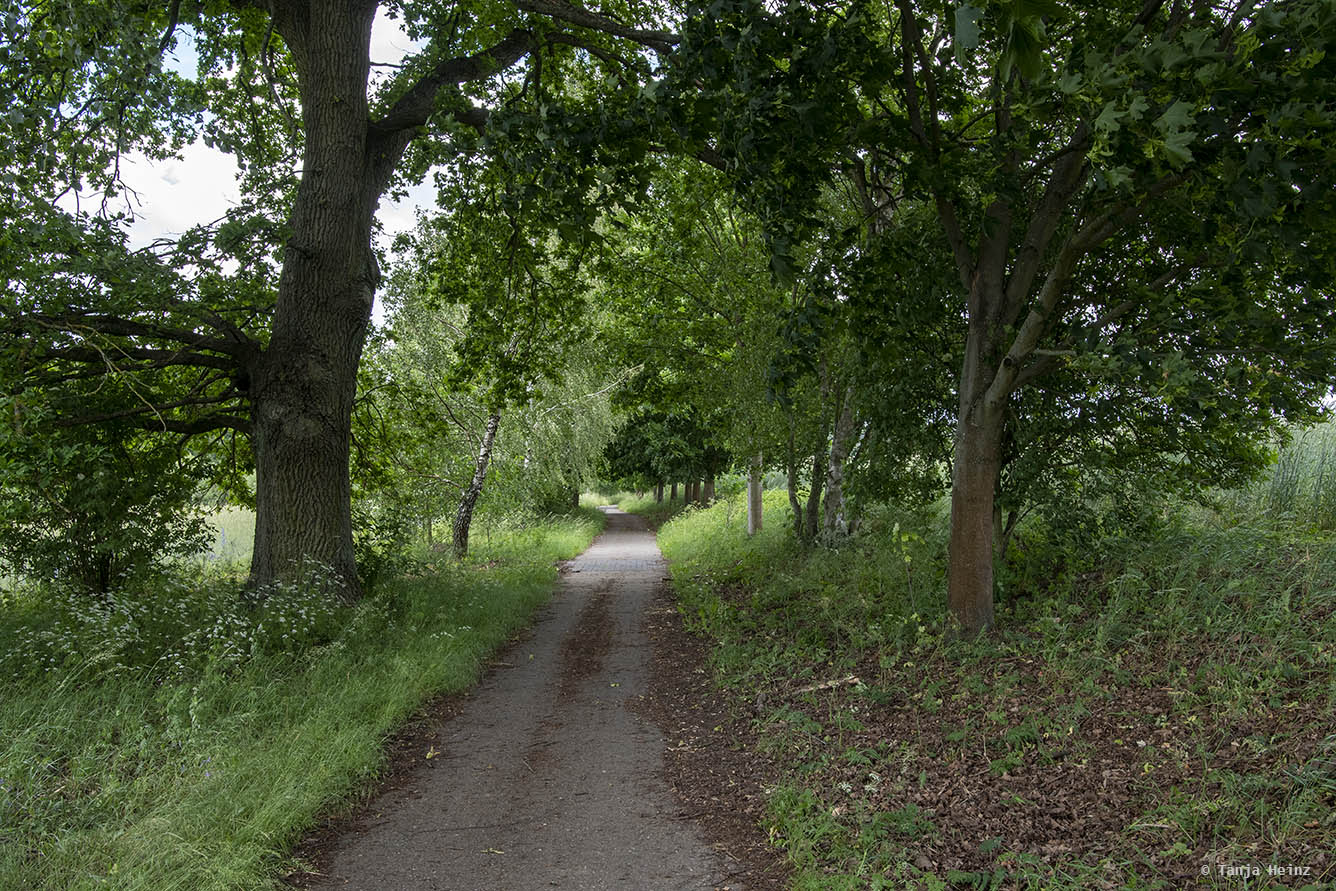
I cycled from Malchow to Lenz and from there passing Petersdorf and Adamshoffnung to Zislow. After Zislow I passed Suckow and headed off into the direction of Bad Stuer. I actually planned to find a path along the Plauer Lake, but I couldn’t find any path. Maybe there is a path as the people of the Youth Hostel where I stayed told me so. However, people in Lenz told me something else. They said that there is a path, but this path is not for bicycles.
Therefore, I chose to take the street. Luckily, I didn’t have to share the street with too many cars most of the time.
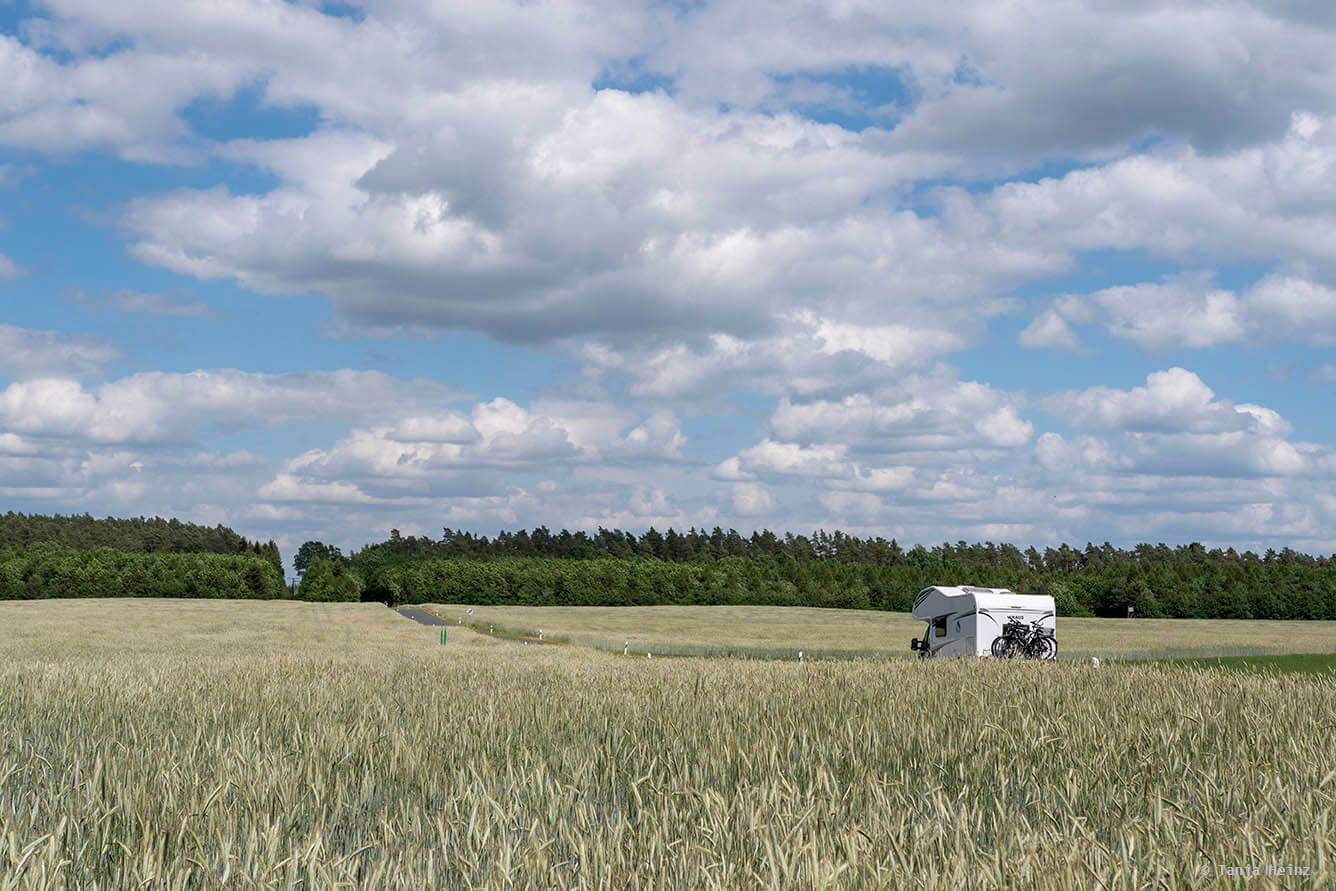
Another thing I want to mention here, there are not so many signs and the map I had was not always that useful. I observed several times other cyclists who were lost like me. Thus, a navigation device might be useful in this area of Mecklenburg-West Pomerania.
Nevertheless, the landscapes are very beautiful, and thus, I didn’t mind to get lost in this region.
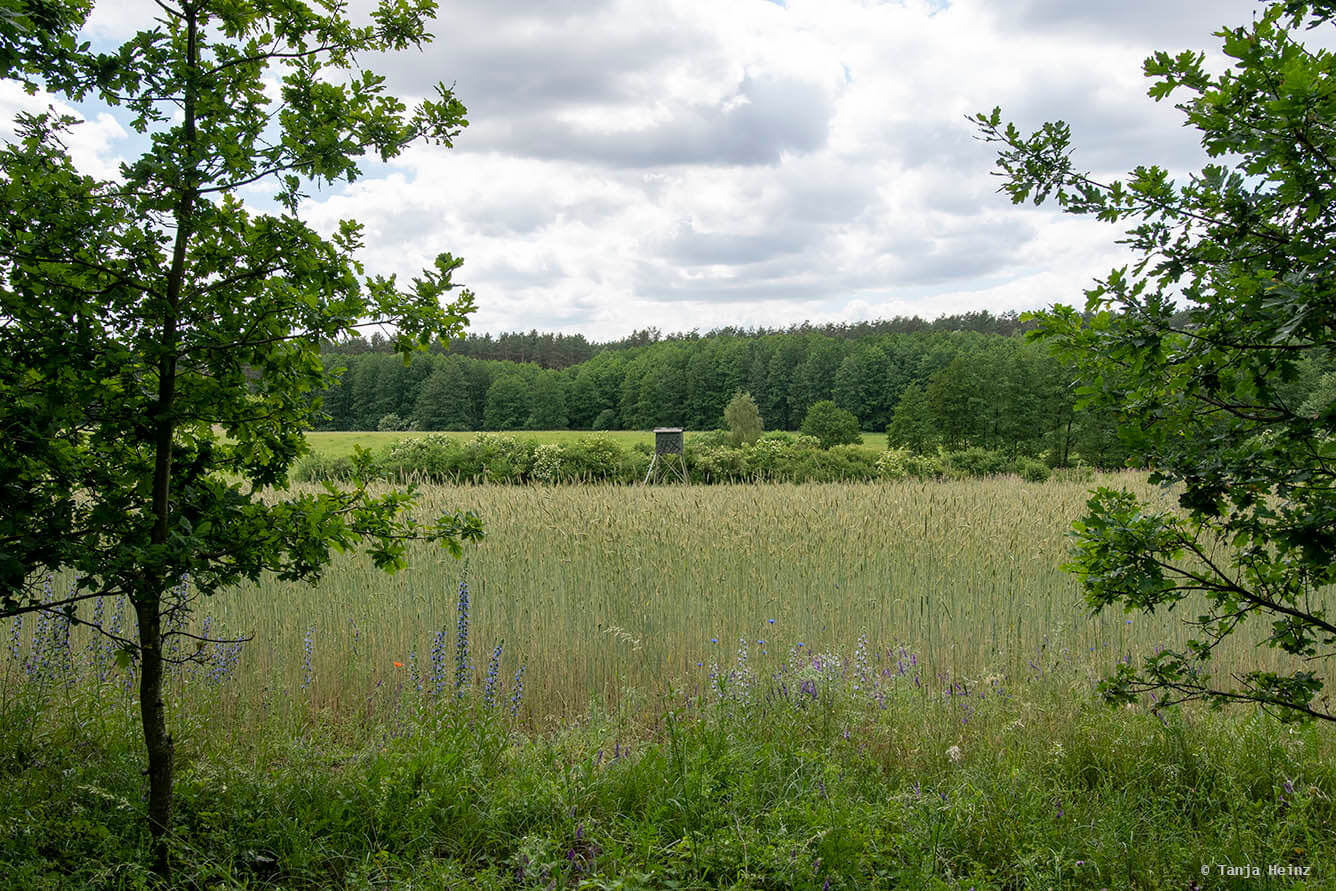
When to visit the bear sanctuary?
You can visit the bear sanctuary Müritz throughout the whole year. From March to October the sanctuary opens from 9 a.m. to 6 p.m. and from November to the middle of March they open from 10 a.m. to 4 p.m. In the main season from March to October the entrance fee is 11 Euros. In the low season visitors have to pay 6,50 Euros. You will find more information about the prices of the bear sanctuary on the official website. On the official website you will also find more information about guided tours, the bears that live in the sanctuary and about the bear sanctuary in general.
More inspiration about close-by trips
The region around the Mecklenburg Lake District is very popular among vacationers. If you are looking for more animal encounters, you can find more in the close-by monkey forest. The monkey forest is close to Malchow, and thus, just about 20 kilometers from the bear sanctuary Müritz.
Have you already been in the bear sanctuary Müritz? Or do you know another bear sanctuary? Maybe you have already seen brown bears in their natural environment? Let me know in the comments.

